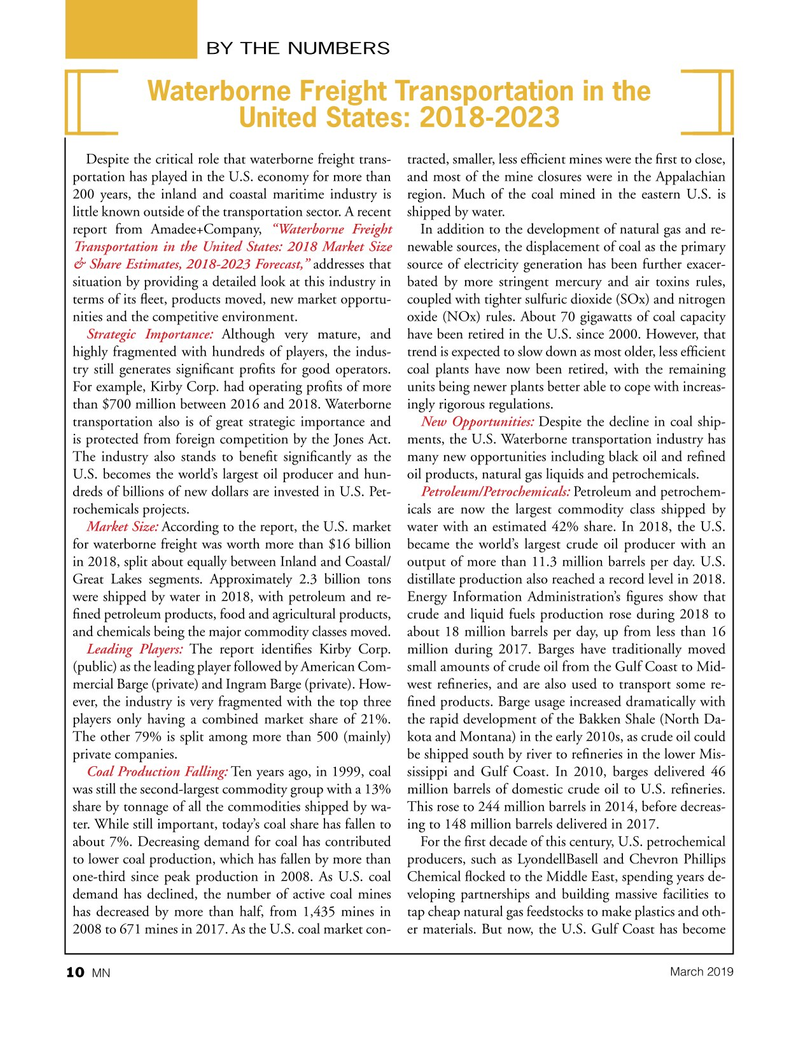
Page 10: of Marine News Magazine (March 2019)
Pushboats, Tugs & Assist Vessels
Read this page in Pdf, Flash or Html5 edition of March 2019 Marine News Magazine
BY THE NUMBERS
Waterborne Freight Transportation in the
United States: 2018-2023
Despite the critical role that waterborne freight trans- tracted, smaller, less effcient mines were the frst to close, portation has played in the U.S. economy for more than and most of the mine closures were in the Appalachian 200 years, the inland and coastal maritime industry is region. Much of the coal mined in the eastern U.S. is little known outside of the transportation sector. A recent shipped by water.
report from Amadee+Company, “Waterborne Freight In addition to the development of natural gas and re-
Transportation in the United States: 2018 Market Size newable sources, the displacement of coal as the primary & Share Estimates, 2018-2023 Forecast,” addresses that source of electricity generation has been further exacer- situation by providing a detailed look at this industry in bated by more stringent mercury and air toxins rules, terms of its feet, products moved, new market opportu- coupled with tighter sulfuric dioxide (SOx) and nitrogen nities and the competitive environment. oxide (NOx) rules. About 70 gigawatts of coal capacity
Strategic Importance: Although very mature, and have been retired in the U.S. since 2000. However, that highly fragmented with hundreds of players, the indus- trend is expected to slow down as most older, less effcient try still generates signifcant profts for good operators. coal plants have now been retired, with the remaining
For example, Kirby Corp. had operating profts of more units being newer plants better able to cope with increas- than $700 million between 2016 and 2018. Waterborne ingly rigorous regulations. transportation also is of great strategic importance and New Opportunities: Despite the decline in coal ship- is protected from foreign competition by the Jones Act. ments, the U.S. Waterborne transportation industry has
The industry also stands to beneft signifcantly as the many new opportunities including black oil and refned
U.S. becomes the world’s largest oil producer and hun- oil products, natural gas liquids and petrochemicals.
dreds of billions of new dollars are invested in U.S. Pet- Petroleum/Petrochemicals: Petroleum and petrochem- rochemicals projects. icals are now the largest commodity class shipped by
Market Size: According to the report, the U.S. market water with an estimated 42% share. In 2018, the U.S. for waterborne freight was worth more than $16 billion became the world’s largest crude oil producer with an in 2018, split about equally between Inland and Coastal/ output of more than 11.3 million barrels per day. U.S.
Great Lakes segments. Approximately 2.3 billion tons distillate production also reached a record level in 2018. were shipped by water in 2018, with petroleum and re- Energy Information Administration’s fgures show that fned petroleum products, food and agricultural products, crude and liquid fuels production rose during 2018 to and chemicals being the major commodity classes moved. about 18 million barrels per day, up from less than 16
Leading Players: The report identifes Kirby Corp. million during 2017. Barges have traditionally moved (public) as the leading player followed by American Com- small amounts of crude oil from the Gulf Coast to Mid- mercial Barge (private) and Ingram Barge (private). How- west refneries, and are also used to transport some re- ever, the industry is very fragmented with the top three fned products. Barge usage increased dramatically with players only having a combined market share of 21%. the rapid development of the Bakken Shale (North Da-
The other 79% is split among more than 500 (mainly) kota and Montana) in the early 2010s, as crude oil could private companies. be shipped south by river to refneries in the lower Mis-
Coal Production Falling: Ten years ago, in 1999, coal sissippi and Gulf Coast. In 2010, barges delivered 46 was still the second-largest commodity group with a 13% million barrels of domestic crude oil to U.S. refneries. share by tonnage of all the commodities shipped by wa- This rose to 244 million barrels in 2014, before decreas- ter. While still important, today’s coal share has fallen to ing to 148 million barrels delivered in 2017.
about 7%. Decreasing demand for coal has contributed For the frst decade of this century, U.S. petrochemical to lower coal production, which has fallen by more than producers, such as LyondellBasell and Chevron Phillips one-third since peak production in 2008. As U.S. coal Chemical focked to the Middle East, spending years de- demand has declined, the number of active coal mines veloping partnerships and building massive facilities to has decreased by more than half, from 1,435 mines in tap cheap natural gas feedstocks to make plastics and oth- 2008 to 671 mines in 2017. As the U.S. coal market con- er materials. But now, the U.S. Gulf Coast has become
March 2019 10 MN

 9
9

 11
11
